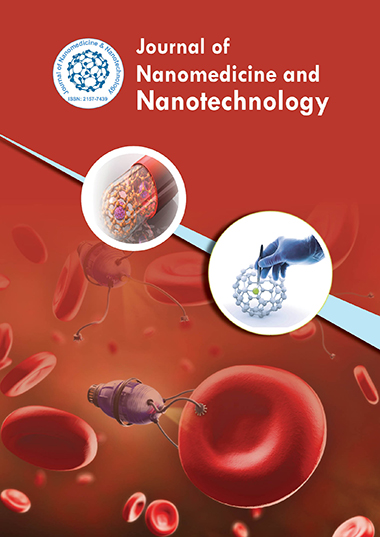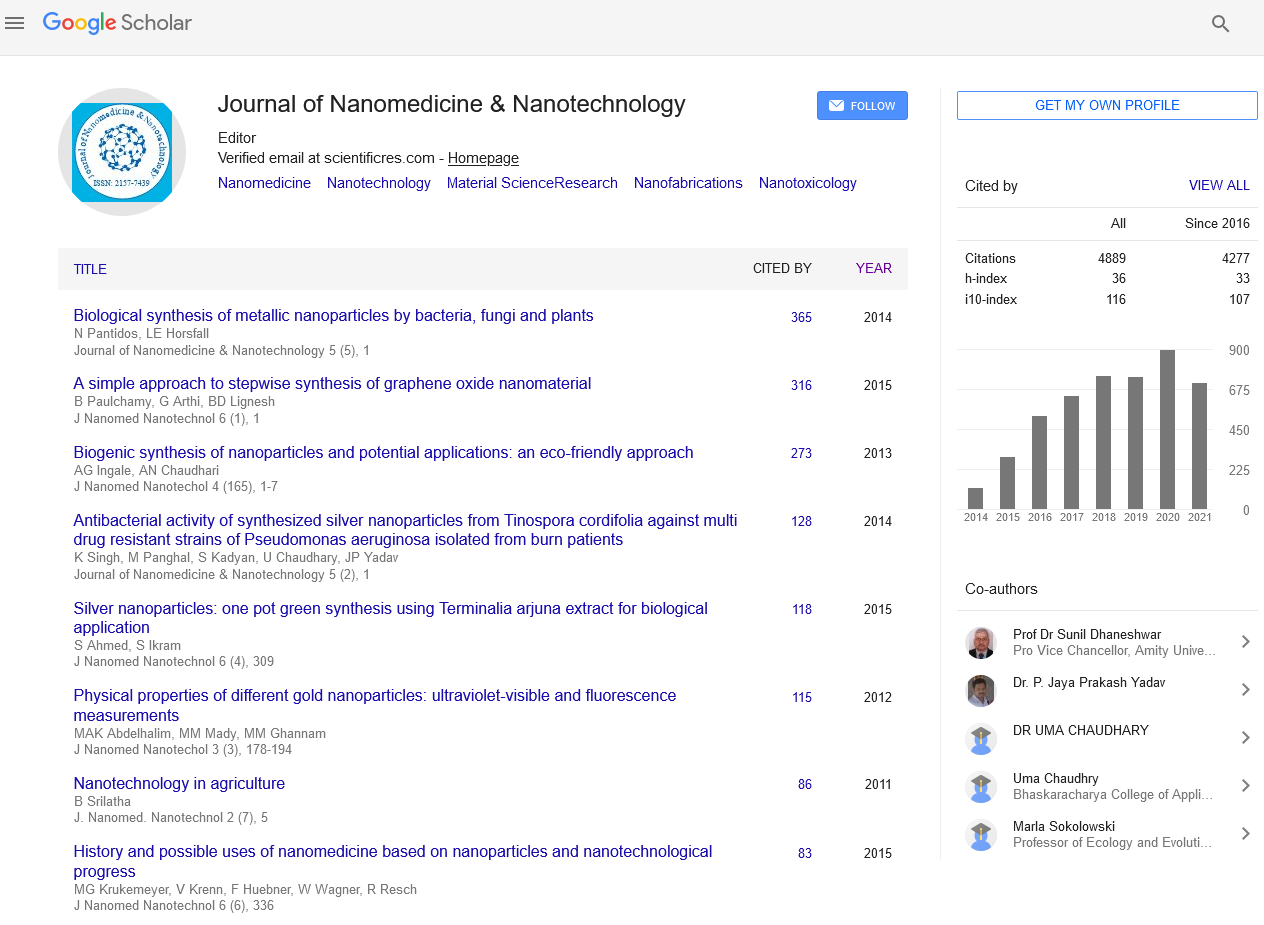Indexed In
- Open J Gate
- Genamics JournalSeek
- Academic Keys
- JournalTOCs
- ResearchBible
- China National Knowledge Infrastructure (CNKI)
- Scimago
- Ulrich's Periodicals Directory
- Electronic Journals Library
- RefSeek
- Hamdard University
- EBSCO A-Z
- OCLC- WorldCat
- SWB online catalog
- Virtual Library of Biology (vifabio)
- Publons
- MIAR
- Scientific Indexing Services (SIS)
- Euro Pub
- Google Scholar
Useful Links
Share This Page
Journal Flyer

Open Access Journals
- Agri and Aquaculture
- Biochemistry
- Bioinformatics & Systems Biology
- Business & Management
- Chemistry
- Clinical Sciences
- Engineering
- Food & Nutrition
- General Science
- Genetics & Molecular Biology
- Immunology & Microbiology
- Medical Sciences
- Neuroscience & Psychology
- Nursing & Health Care
- Pharmaceutical Sciences
Editorial - (2025) Volume 16, Issue 1
Nanoparticle-Mediated Delivery of Epigenetic Modifiers for Reprogramming of Cancer Cells
Tsubasa Kobayashi*Received: 01-Jan-2025, Manuscript No. jnmnt-25-28317; Editor assigned: 03-Jan-2025, Pre QC No. jnmnt-25-28317 (PQ); Reviewed: 16-Jan-2025, QC No. jnmnt-25-28317; Revised: 23-Jan-2025, Manuscript No. jnmnt-25-28317 (R); Published: 31-Jan-2025, DOI: 10.35248/2157-7439.24.16.770
INTRODUCTION
Cancer is characterized by genetic mutations, chromosomal instability, and altered gene expression, which drive tumor progression and therapy resistance. Epigenetic modifications, including DNA methylation, histone modifications, and non-coding RNA regulation, are key contributors to these changes. Unlike genetic mutations, epigenetic modifications are reversible, offering a unique opportunity to therapeutically reprogram cancer cells. However, the efficient delivery of epigenetic modifiers to tumor cells remains a significant challenge. Nanoparticles (NPs) have emerged as promising carriers for the delivery of epigenetic modifiers due to their ability to encapsulate diverse compounds, improve bioavailability, and target specific tissues. This article explores the potential of nanoparticle-mediated delivery of epigenetic modifiers in the reprogramming of cancer cells, focusing on mechanisms, advantages, and future directions in cancer treatment [1].
EPIGENETIC MODIFICATIONS AND CANCER
Epigenetic modifications refer to heritable changes in gene expression that do not involve alterations in the underlying DNA sequence. These modifications play a central role in regulating gene activity and can be influenced by environmental factors, lifestyle, and disease states, including cancer. In cancer, epigenetic changes often result in the silencing of tumor suppressor genes, activation of oncogenes, and alterations in the expression of genes involved in cell cycle regulation, apoptosis, and DNA repair. Key epigenetic mechanisms that contribute to cancer include DNA methylation, histone modifications, and changes in non-coding RNA expression. DNA hypermethylation of CpG islands in the promoter regions of tumor suppressor genes is a well-known hallmark of many cancers. Histone modifications, such as acetylation, methylation, and phosphorylation, can also affect chromatin structure and gene expression, promoting a pro-tumorigenic environment. Furthermore, non-coding RNAs, including microRNAs and long non-coding RNAs, regulate gene expression post-transcriptionally and play critical roles in cancer initiation and progression [2]. Reversing or modifying these epigenetic alterations holds great promise for cancer therapy. Epigenetic drugs, such as DNA methyltransferase inhibitors, histone deacetylase inhibitors, and small molecules that target non-coding RNAs, can potentially restore the normal function of silenced genes or inhibit the expression of oncogenes. However, the clinical application of these epigenetic modifiers has been hindered by issues such as poor bioavailability, off-target effects, and difficulties in delivering the agents to specific tumor sites [3].
NANOPARTICLE-MEDIATED DELIVERY OF EPIGENETIC MODIFIERS
Nanoparticles have the potential to overcome many of the limitations associated with traditional epigenetic drugs. The ability to encapsulate or conjugate epigenetic modifiers to nanoparticles allows for enhanced stability, protection from degradation, and controlled release of the therapeutic agents. Additionally, nanoparticles can be engineered to improve the solubility and bioavailability of hydrophobic compounds, which are commonly found among epigenetic modifiers. A key advantage of using nanoparticles for the delivery of epigenetic modifiers is their ability to target specific cells or tissues. Surface functionalization of nanoparticles with ligands, such as antibodies, peptides, or small molecules, allows for selective targeting of cancer cells, minimizing off-target effects and enhancing therapeutic efficacy. Targeting can be directed to overexpressed receptors on tumor cells or to specific features of the tumor microenvironment, such as hypoxia or acidity, ensuring that the epigenetic modifiers reach the intended cells [4]. Nanoparticles can deliver a variety of epigenetic modifiers, including small molecules, nucleic acids, and histone-modifying enzymes. For instance, nanoparticles can encapsulate DNA methyltransferase inhibitors like 5-azacytidine or histone deacetylase inhibitors like vorinostat. Additionally, nanoparticles can be used to deliver small interfering RNA (siRNA) or short hairpin RNA (shRNA) that target genes involved in epigenetic regulation, such as DNMT1 (DNA methyltransferase 1) or HDACs (histone deacetylases). These strategies can reverse aberrant epigenetic modifications and restore normal gene expression in cancer cells [5].
MECHANISMS OF EPIGENETIC REPROGRAMMING BY NANOPARTICLES
Nanoparticles can modulate cancer cell epigenetics by either directly interacting with the chromatin or indirectly influencing the epigenetic machinery. For instance, nanoparticles can deliver small molecules that inhibit DNA methyltransferases, leading to the demethylation of tumor suppressor gene promoters and the subsequent reactivation of these genes. Similarly, nanoparticles loaded with histone deacetylase inhibitors can promote histone acetylation, loosening the chromatin structure and facilitating the transcription of silenced tumor suppressor genes. In addition to small molecules, nanoparticles can also deliver epigenetic regulators in the form of RNA. RNA-based therapies, such as siRNA or antisense oligonucleotides, can target specific genes involved in the epigenetic control of gene expression. For example, siRNA targeting DNMT1 can reduce DNA methylation levels, leading to the reactivation of silenced genes. Similarly, nanoparticles can deliver RNA molecules that target microRNAs or long non-coding RNAs that regulate the expression of key oncogenes or tumor suppressors [6]. Furthermore, nanoparticles can be designed to enhance the delivery of chromatin-modifying enzymes directly to the cancer cells. Enzymes such as methyltransferases, acetyltransferases, or demethylases can be encapsulated within nanoparticles, and upon cellular uptake, they can modify the chromatin structure and restore normal gene expression patterns [7].
ADVANTAGES OF NANOPARTICLE-MEDIATED EPIGENETIC THERAPY
The use of nanoparticles to deliver epigenetic modifiers offers several advantages over conventional methods. One of the most significant benefits is the ability to achieve targeted, localized delivery of the epigenetic drugs. This selective targeting minimizes systemic toxicity, which is a common problem with traditional epigenetic therapies, and enhances the therapeutic effect by ensuring that the drugs are concentrated in the tumor microenvironment. Another advantage is the controlled release of epigenetic modifiers from nanoparticles. By modifying the nanoparticle design, such as using pH-sensitive or enzyme-responsive materials, the release of the epigenetic agents can be triggered specifically within the tumor cells. This approach reduces off-target effects and ensures that the drugs are released at the site of action, improving treatment efficacy [8]. Nanoparticle-mediated delivery also allows for the co-delivery of multiple epigenetic modifiers or the combination of epigenetic therapy with other therapeutic modalities, such as chemotherapy or immunotherapy. This multi-modal approach can enhance the overall effectiveness of cancer treatment by targeting different aspects of tumor biology simultaneously, including both the epigenetic and genetic factors that drive tumorigenesis [9].
CHALLENGES AND FUTURE DIRECTIONS
Despite the promising potential of nanoparticle-mediated delivery of epigenetic modifiers, several challenges remain. One of the main concerns is the potential toxicity of nanoparticles, particularly with long-term or repeated exposure. While nanoparticles are generally considered biocompatible, their long-term fate in the body, including potential accumulation in organs such as the liver or spleen, needs to be carefully evaluated. Another challenge is the complexity of the tumor microenvironment. Cancer cells are highly heterogeneous, and the epigenetic changes that drive tumorigenesis can vary widely between different cancer types and even within a single tumor. Therefore, developing universal nanoparticle-based therapies that can effectively target a wide range of epigenetic alterations remains a challenge. In addition, the development of nanoparticles capable of efficiently crossing biological barriers, such as the blood-brain barrier in the case of brain tumors, is an area of active research. Overcoming these barriers would significantly expand the applicability of nanoparticle-mediated epigenetic therapy in a broader range of cancers [10].
CONCLUSION
Nanoparticle-mediated delivery of epigenetic modifiers holds great promise for the reprogramming of cancer cells and the development of more effective cancer therapies. By enabling targeted, controlled delivery of epigenetic agents, nanoparticles offer the potential to reverse aberrant gene expression, reactivate tumor suppressor genes, and inhibit oncogenes. This approach provides a unique therapeutic strategy for cancers that are resistant to conventional treatment. While challenges remain in optimizing nanoparticle formulations and ensuring their safety, ongoing advancements in nanotechnology and epigenetics are likely to lead to innovative and personalized therapies that can improve outcomes for cancer patients.
REFERENCES
- Parker N, Smith A. Multiple Myeloma Antibodies and Targeted Therapies. Hematol Oncol Clin North Am. 2019; 33(1): 37-55.
- Smith A M, Lee K. Conjugated Polymer Nanoparticles for Imaging and Therapeutics. Bioconjugate Chemistry. 2022; 33(1): 1-13.
- Brown M, Anderson R, Artis D. Intestinal Memory CD4+ T Cells Function to Suppress Inflammation in the Gut. Journal of Immunology. 2018; 187: 16-187.
- Anderson J C, White K A. Structure of the African swine fever virus major capsid protein p72. Cell Reports. 2021; 36(7): 109454.
- Johnson D E, O'Keefe R A, Grandis J R. Targeting the IL-6/JAK/STAT3 signalling axis in cancer. Nat Rev Clin Oncol. 2022;19(3): 208-222.
- Schleich N, Sibret P, Danhier P, Ucakar B, Laurent S, Muller R N, Â et al. Dual anticancer drug/superparamagnetic iron oxide-loaded PLGA-based nanoparticles for cancer therapy and magnetic resonance imaging. Int J Pharm. 2014;466(1-2): 172-185.
- Miller K D, Nogueira L, Mariotto A B, Rowland J H, Yabroff K R, Alfano, et al. Cancer treatment and survivorship statistics, 2019. CA Cancer J Clin. 2020; 69(5): 363-385.
- Lee S, Patel T. Tumor-Targeted Drug Delivery Utilizing Engineered T Cells. Frontiers in Immunology. 2018; 9: 2294.
- Garcia J R, Davis J. Probing Targeted Nanoparticle Surface Interactions with Cellular Membranes. ACS Nano. 2019; 13(8): 9137-9151.
- Smith A M, Davis J. Increasing the accuracy of nanoparticle sensing using a multi-level gating approach. Nature Communications. 2019; 10(1): 1-9.
Indexed at, Google Scholar, Crossref
Indexed at, Google Scholar, Crossref
Indexed at, Google Scholar, Crossref
Indexed at, Google Scholar, Crossref
Indexed at, Google Scholar, Crossref
Citation: Tsubasa K (2025) Nanoparticle-Mediated Delivery of Epigenetic Modifiers for Reprogramming of Cancer Cells. J Nanomed Nanotech. 16: 770.
Copyright: ©2025 Tsubasa K. This is an open-access article distributed under the terms of the Creative Commons Attribution License, which permits unrestricted use, distribution, and reproduction in any medium, provided the original author and source are credited.


